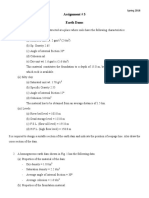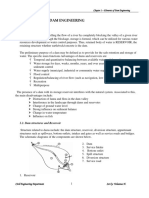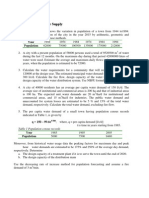Assignment 1
Uploaded by
donatus_okoroAssignment 1
Uploaded by
donatus_okoroWater Supply and Urban Drainage Assignment1
1. The following data shows the variation in population of a town from 1944 to1994. Estimate the population of the city in the year 2015 by arithmetic, geometric and decreasing rate of increase methods. 1944 1954 1964 1974 1984 1994 Year 62000 75000 100500 135000 175000 212000 Population 2. A city with a present population of 58000 persons used a total of 9526500 m3 of water during the last 12 months. On the maximum day during that period 42000000 liters of water were used. Estimate the average and maximum daily flows to be expected in 20 years, when the population is estimated to be 72000. 3. Calculate the water requirements for a community that will reach a population of 120000 at the design year. The estimated municipal water demand for the community is 300 l/c/d. Calculate the fire flow, design capacity of the water treatment plant, and design capacity of the water distribution system. Use NBFU formula for fire flow. 4. A city of 40000 residents has an average per capita water demand of 150 l/c/d. The average size of institutional and commercial areas is 200 ha and that of industrial areas is 100 ha. The expected unit water demands are 20 m3/ha/d for institutional and commercial areas, and 15 m3/ha/d for industries. The public water demand and unaccounted for system losses are estimated to be 5 % and 15% of the total water demand, respectively. Calculate the total water demand, excluding fire flow. 5. The per capita water demand of a small town having population census records indicated in Table 1, is given by where, q = per capita demand [l/c/d] t is time in years starting from 1985. Table 1 Population census records 1985 1995 2005 Year 5000 7500 9480 Population Moreover, from historical water usage data the peaking factors for maximum day and peak hour water demands are estimated to be 175% and 250% of the average day demand, respectively. Determine a. The design capacity of a treatment plant if it is to serve the town until the end of 2020. b. The design capacity of the distribution main Use the decreasing rate of increase method for population forecasting and assume a fire demand of 3 m3/min. q = 150 99.6e-0.04t;
You might also like
- CIV238 U1 L15 Water Demand and Quantity of Water100% (1)CIV238 U1 L15 Water Demand and Quantity of Water58 pages
- Lec-8 (Water Quantity Population Esimation) PDFNo ratings yetLec-8 (Water Quantity Population Esimation) PDF42 pages
- Mekelle Uninversity Ethiopian Instituite of Techonology - Mekelle School of Civil EngineringNo ratings yetMekelle Uninversity Ethiopian Instituite of Techonology - Mekelle School of Civil Enginering39 pages
- Lec 5 Fire Demand & Variation in Water Consumption PDF75% (4)Lec 5 Fire Demand & Variation in Water Consumption PDF19 pages
- Dam Safety & Water Resource Planning Project (DSWRPP) Background100% (1)Dam Safety & Water Resource Planning Project (DSWRPP) Background2 pages
- Department of Mechanical Engineering/ Hachalu Hundessa Campus Ambo University Meng2141No ratings yetDepartment of Mechanical Engineering/ Hachalu Hundessa Campus Ambo University Meng21416 pages
- CE532, Wastewater Engineering: Lecture 3 & 4 Sewage & Stormwater Quantity EstimationNo ratings yetCE532, Wastewater Engineering: Lecture 3 & 4 Sewage & Stormwater Quantity Estimation24 pages
- Lecture 3 Wastewater Flows and CharacteristicsNo ratings yetLecture 3 Wastewater Flows and Characteristics30 pages
- Chap 3 - 1 Irrigation Distribution NetworkNo ratings yetChap 3 - 1 Irrigation Distribution Network48 pages
- Design Procedure For Sanitary Sewers: Sewerage and Urban Drainage SystemNo ratings yetDesign Procedure For Sanitary Sewers: Sewerage and Urban Drainage System5 pages
- IRRIGATION SYSTEMS DESIGN NOTES - MR Mpala LSUNo ratings yetIRRIGATION SYSTEMS DESIGN NOTES - MR Mpala LSU163 pages
- 00 - Analysis of Hydraulic Network Using Hardy Cross in Excel and EpanetNo ratings yet00 - Analysis of Hydraulic Network Using Hardy Cross in Excel and Epanet7 pages
- A Redesign of Eenhana Waste Stabilization Ponds in Namibia by Israel HaimbiliNo ratings yetA Redesign of Eenhana Waste Stabilization Ponds in Namibia by Israel Haimbili56 pages
- Planning Catchment Area Treatment CATusing GISand Remote SensingNo ratings yetPlanning Catchment Area Treatment CATusing GISand Remote Sensing12 pages
- Haramaya Institute of Technology: School of Water Resource and Environmental EngineeringNo ratings yetHaramaya Institute of Technology: School of Water Resource and Environmental Engineering94 pages
- Presentation On Determination of Water Potential of The Legedadi CatchmentNo ratings yetPresentation On Determination of Water Potential of The Legedadi Catchment25 pages



























































